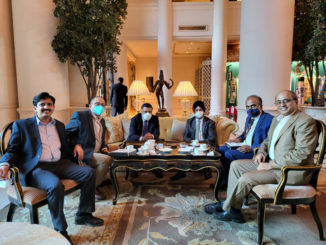
Indian constitution, one of the utmost admired constitutions in the world was enacted after ‘ransacking’ all the known constitutions of the world at that time. This constitution that we have enacted has stood the test of times. Though provisions were borrowed from other constitutions, the constitution of India has several salient features that distinguish it from constitution of other countries
Some of its salient features are discussed below:
Lengthiest written constitution
Constitution can be classified into written constitution such as that of America or unwritten constitution such as that UK.
The constitution of India is a written constitution which happens to be the lengthiest written constitution in the world.
It is comprehensive, elaborate and a detailed document
The factors that have contributed to this phenomenon are: geographical factors (vastness of country and diversity), Historical factors (Influence of GoI, 1935), Single constitution for both centre and state and dominance of legal luminaries
Drawn from various sources
It has borrowed most of its provisions from the constitution of various other countries as well as from the Government of India act, 1935. Ex: structural part from GoI, 1935, independence of judiciary from USA, Fundamental Rights from USA etc
Though it is borrowed, the Indian constitution-makers made sure the borrowed features were made suitable to Indian conditions. Ex: Though we borrowed cabinet form of governance from UK, the cabinet is not all-supreme as in the case of UK.
Preamble of the constitution
The Preamble consists of the ideals, objectives and basic principles of the Constitution.
The salient features of the Constitution have developed directly and indirectly from these objectives which flow from the Preamble
It asserts India to be a Sovereign Socialist Secular Democratic Republic and a welfare state committed to secure justice, liberty and equality for the people and for promoting fraternity, dignity the individual, and unity and integrity of the nation.
The Preamble is the nature of Indian state and the objectives it is committed to secure for the people.
Democratic system
The authority of the government rests upon the sovereignty of the people. The people enjoy equal political rights.
Free fair and regular elections are held for electing governments
India is a republic
The Preamble declares India to be a Republic.
India is not ruled by a monarch or a nominated head of state. India has an elected head of state (President of India) who wields power for a fixed term of 5 years.
After every 5 years, the people of India indirectly elect their President.
Union of states
Article I of the Constitution declares, that “India that is Bharat is a Union of States.”
Fundamental Rights and duties
The Constitution of India grants and guarantees Fundamental Rights to its citizens.
The constitution of India confirms the basic principle that every individual is permitted to enjoy certain basic rights and part III of the Constitution deals with those rights which are known as fundamental right.
The Six FR include- Right to Equality; Right to Freedom; Right Against Exploitation; Right to Freedom of Religion; Cultural and Educational Rights and Right to Constitutional Remedies (Art. 32).
The fundamental rights are justiciable and are not absolute. Reasonable constraints can be imposed keeping in view the security-requirements of the state.
A new part IV (A) after the Directive Principles of State Policy was combined in the constitution by the 42nd Amendment, 1976 for fundamental duties.
Directive Principles of State Policy
A unique aspect of the Constitution is that it comprises of a chapter in the Directive Principles of State Policy.
These principles are in the nature of directives to the government to implement them to maintain social and economic democracy in the country.
Parliamentary System:
The Constituent Assembly decided to espouse Parliamentary form of government both for the Centre and the states.
In Indian parliamentary system, distinction is made between nominal and real executive head.
The Council of Ministers is responsible before the Lok Sabha, The lower house of union parliament. There are close relations between executive and legislature.
Federal structure of government
A federal state is a state where a country is divided into smaller regions and the government is functioning at two levels
The Indian Constitution has envisaged a federal structure for India considering the geographical vastness and the diversity of languages, region, religions, castes, etc.
Written Constitution, supremacy of the Constitution, division of powers between Union and States, bicameral Legislature, independent Judiciary, etc. are the features of Indian federation.
Scholars describe India as a ‘Quasi-Federation’ (K.C. Wheare) or as ‘a federation with a unitary bias, or even as ‘a Unitarian federation.’
Universal adult franchise
All men and women enjoy an equal right to vote. Each adult man and woman above the age of 18 years has the right to vote.
All registered voters get the opportunity to vote in elections.
Single integrated State with Single Citizenship:
India is the single Independent and Sovereign integrated state.
All citizens enjoy a common uniform citizenship.
They are entitled to equal rights and freedoms, and equal protection of the state.
Integrated Judicial system
The Constitution provides for a single integrated judicial system common for the Union and the states.
The Supreme Court of India works at the apex level, High Courts at the state level and other courts work under the High Courts.
Independent Judiciary
It is necessary to secure the philosophical foundations of the rule of law and democracy
Firstly, the Constitution makers created a separate Judiciary independent of Legislature and Executive.
Secondly, the Constitution has ensured complete independence of Judiciary in the matters of administration and finances.
Amending the Constitution of India
Amending the Constitution of India is the procedure of making modifications to the nation’s fundamental law or supreme law.
The procedure of amendment in the constitution is laid down in Part XX (Article 368) of the Constitution of India.
This procedure guarantees the sanctity of the Constitution of India and keeps a check on uninformed power of the Parliament of India.
Judicial Review
The judiciary has significant position in Indian Constitution and it is also made independent of the legislature and the executive.
The Supreme Court of India stands at the peak of single integrated judicial system
It operates as defender of fundamental rights of Indian citizens and guardian of the Constitution.
Basic Structure doctrine
The basic structure doctrine is an Indian judicial norm that the Constitution of India has certain basic features that cannot be changed or destroyed through amendments by the parliament.
The basic features of the Constitution have not been openly defined by the Judiciary. At least, 20 features have been described as “basic” or “essential” by the Courts in numerous cases, and have been incorporated in the basic structure.
In Indira Gandhi v. Raj Narayan case and also in the Minerva Mills case, it was witnessed that the claim of any particular feature of the Constitution to be a “basic” feature would be determined by the Court in each case that comes before it.
Secularism
In no other country of the world so many religions co-exist as in India. In view of such diversity the Constitution guarantees complete freedom of religion to all. The citizens of our country are free to follow any religion and they enjoy equal rights without any distinction of caste, creed, religion or sex.





Be the first to comment